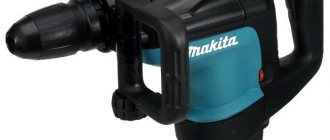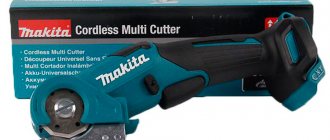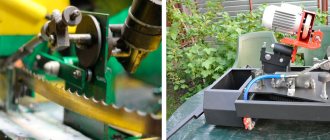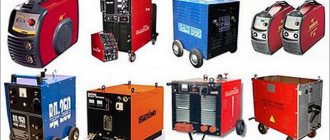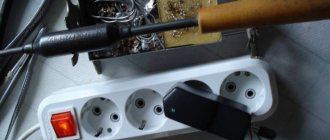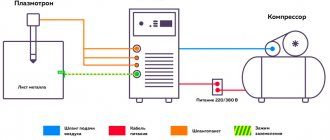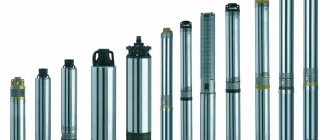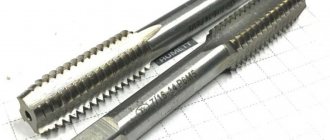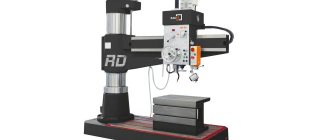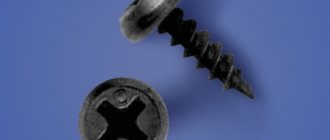After construction or major renovation of premises, it is necessary to install communication equipment: heating, water supply, electrical wiring, communication cables, without which modern residential and office premises will not be fully functional.
For quick and accurate installation of all equipment around the house, it is necessary to prepare a route for its installation; for this you need holes of various diameters in the walls and floor, niches for sockets and distribution boxes, grooves for laying trays for power wires and cables. The main tool used for drilling holes in walls is a concrete drill with an sds shank. What it is and how to choose the right drill can be found in the material below.
Drilling technology
Without going into the details of modern technologies for drilling with laser or ultrasonic machines, the main tool for drilling holes in various materials is a drill and hammer drill. The difference between this tool is that the drill is designed for drilling holes - a hammer drill for drilling.
There are different types of drills, but the principle of their operation is the same - this is the removal of a layer of material, so the cutting part is sharpened in such a way that there is a sharp edge that cuts off a layer of material - this applies to “sticky” materials: wood, metal, plastic and various alloys of them.
It will not be possible to cut a layer of high-strength concrete products, special types of expanded clay or basalt rocks with a sharp edge: since the hardness of the stone exceeds the material of the drill, and if we take into account that modern concrete is made with a filler of iron oxides, then it is better not to think about drilling and don't even think.
To get out of the situation, concrete drills were invented.
Drill device for concrete
The principle of operation of a drill differs from a drill in that it does not drill, but destroys the material on which it is used. Therefore, using drills for drilling metal is completely unsuitable, and using a drill for drilling stone is generally unacceptable.
If you look at the tip of the drill, you can see that there are two or four carbide tips at the ends. (in Russia VK8-VK10 - “Win”). The sharpening of the soldering edges - flat - are at an angle of 60 0 from each other. It is this sharpening and arrangement that allows the concrete structure to be destroyed with simultaneous impact - torsion. The hard edges of the drill break off particles of concrete, which come out through the ring grooves.
When using the drilling method, the quality of the concrete drill itself for the sds rotary hammer and the tool with which it is used comes first. The thing is that when drilling, the impact force is not so important (this is not a chipper); here the quality of drilling is determined by the frequency of impacts and the accuracy of their directions to the center of the drill body. In other words, the more accurately the drill is made, and the hammer blows are directed exactly to the center of the working tool and their frequency is more than 10 per second, making a hole in a concrete wall becomes a simple and easy task, regardless of its diameter.
In what case should you purchase a hammer drill with an SDS-Max chuck?
If light and medium hammer drills are suitable for drilling, installing anchors, dowels, and chiselling a wall to make a hole for communications, then the SDS-Max models can perform the function of a real jackhammer.
With their help you can easily:
- remove a thick layer of reinforced concrete;
- destroy a wall partition made of brickwork or concrete blocks;
- remove asphalt from the road;
- split heavy rock.
They can be used for simpler tasks (drilling a hole for a cable or pipe in the wall, making a ventilation outlet, cutting a niche for an outlet, etc.), but due to the increased power of the tool, such work will be completed much faster. Therefore, SDS Max hammer drills are purchased not only for heavy dismantling work, but also for installing electrical or plumbing in large volumes. Then they pay off due to productivity and help to deliver the project faster.
Rotary hammers with SDS Max cartridges weigh from 5 kg, which is important to consider when choosing, because if you have to work a lot on the ceiling, you will need more frequent breaks. Security requirements here are much higher. The lightweight SDS+ can weigh 3-4kg, making it much easier to hold at height. The operation of this powerful tool requires a highly skilled operator and is therefore only suitable for professional use.
Understanding the purpose of a powerful tool, let’s consider the rating of SDS-Max rotary hammers, which will help you see already tested models with positive reviews. The advantages and disadvantages of the product will simplify your choice and allow you to spend your money wisely.
Hammer hammer design
All rotary hammers have two types of impact devices used - ratchet and impact mechanisms.
Ratchet mechanism
The principle of operation of the ratchet mechanism is based on the sliding of two notched coupling halves relative to each other, which creates an impact effect. Similar devices are used in relatively low-power hammer drills and drills. The use of a ratchet in a powerful hand tool limits the disadvantages: the recoil force is equal to the force of impact on the working tool, intense wear of the coupling halves, the intensity of vibration depends on the force of pressing, that is, on the use of muscle force, the more powerful the tool, the more difficult it is to do this. It is recommended to use a concrete drill sds no more than 6x110mm with such a device. The most progressive has been the use of a device with an oscillating bearing. The oscillatory motion during rotation is created by the eccentric outer race of the bearing (which is popularly called drunk). The clip, swinging relative to the ellipse, sets in motion the rocker, which is connected at its outer end to the piston of the impact mechanism. The piston of the impact tool, making a horizontal movement, strikes the striker, which in turn transmits the impact energy to the working element. This device is used on rotary hammers with a power of up to 5 kW, which is optimal for concrete drill sds 10x210. More powerful hammer drills use another type of impact piston drive device - a swinging rocker, in which the role of the piston drive is assigned to the eccentric rocker of the piston drive by a connecting rod drive. The piston moving along the cylinder creates an impact load on the firing pin. This design is interesting in that there is a counter-weight on the slide that absorbs part of the recoil energy, working in the opposite direction to the main piston. (analogous to a car crankshaft). Also, in such designs, an air shockproof system is used to further soften the recoil force. Large concrete drills sds 32 1000 and concrete drills sds 25x600 are used with such hand tools.
SDS – shanks on drills and their qualification
Depending on the power of the hammer drill, chucks such as SDS-plus, SDS-max, SDS-top and SDS-quick are used.
The design of the SDS cartridge is quite simple. There are four recesses on the drill shank (two are used on SDS chucks up to 8 mm). Two closed and two open. Open ones serve to properly fix the shank in the chuck and transmit shock-rotational motion to the working element. The closed slots align with the locking balls in the chuck and serve to secure the tool in the chuck. When you press the moving part of the chuck, these balls come out of the grooves in the shank and the tool is released.
SDS+
The sds plus concrete drill shanks for hammer drills in this category are designed for medium-power power tools with a diameter of 10 to 18 mm with a corresponding chuck. These diameters are the most popular among repairmen. If necessary, you can always order or purchase a set of sds plus concrete drills with different shank diameters in any required range.
SDS – max
concrete drills sds max have a shank diameter of 18 mm or more, are classified as professional and require appropriate equipment, which includes not only hand tools, but also guides, special dust extractors and vacuum cleaners. Particularly popular are concrete drills 32 sds with different drill lengths (from 100 to 600mm).
SDS-top and SDS-quick are used in professional and special hammer drills that have a specific slotting mechanism and are not discussed in this article.
August 17, 2015In this article, we summarized the available information about the equipment for rotary hammers, classified it by types of shanks, the method of working with the equipment (drilling, hammer drilling, chiselling) and gave general recommendations for its use.
Content:
1. Concept 2. Types of shanks – SDS – SDS-plus – SDS-max – SDS-top – SDS-quick – SDS-hex 3. Types of drills – spiral drills – auger drills – flat drills – breakout drills – drill with dust extraction 4. Chisels 5. Core bits 6. Drill adapters 7. Operating instructions
1. Concept
Equipment for rotary hammers is designed for processing hard materials (concrete, brick, natural or artificial stone) by impact, rotation, impact with rotation.
Rotation refers to the rotational movement of the equipment. It is used for drilling, impact drilling, hammer drilling, and core drilling technology.
By impact we mean the axial movement (reciprocating movement) of the equipment. Impact is used for impact drilling, hammer drilling and chiselling.
Equipment for rotary hammers can be classified by the type of shank and by the method of impact on the material being processed (drilling, including impact - drills and crowns; impact - chisels).
2. Types of shanks
The equipment for a hammer drill has a special shank, with the help of which the equipment is secured in the device for fastening the equipment of the hammer drill and which transmits the impact force to the working part of the equipment. The separation of the tool clamping device and the force transmission device allows the tool to be attached to the power tool without the use of additional tools (for example, a socket wrench for the chuck).
The most widespread are rotary hammers with chucks with the ability to quickly change tools using the SDS system developed by Bosch.
The literal translation from English (Special Direct System - special direct system) gives a general, but far from complete answer to this question. The German definition is much simpler and clearer - “INSERT-TURN-SIT” (Steck-Dreh-Sitzt). In Russian technical literature, SDS is accepted as a system for quickly changing equipment without the help of any devices.
In total, Bosch has developed 5 types of shank: SDS, SDS-plus, SDS-top, SDS-max, SDS-quick. However, two standards are most widespread and popular: SDS-plus - for light rotary hammers and SDS-max - for heavy ones, as they are the most popular in the construction market.
SDS
A shank with two grooves with a diameter of 10 mm, which is inserted 40 mm into the hammer drill chuck. This shank is 100% compatible with the SDS-plus shank.
SDS-plus
Today, almost 90% of rotary hammers are equipped with the SDS-plus system, developed by Bosch in 1975 based on the SDS system by adding two grooves. Already in 1998, more than 10 million hammer drills of this standard were sold.
The SDS-plus shank is a 10mm diameter shank that fits 40mm into the hammer drill chuck. The shank has four grooves (two open for guide wedges and two closed for fixation with locking balls). The contact area of the wedges is 75 mm2.
Drills with such a shank are used on light construction hammer drills; the minimum length of drills with such a shank is about 110 mm and the maximum is 1000 mm. The diameter of the drill is usually from 4 to 26 mm (the most common diameters are 6, 8, 10 and 12 mm).
To release the equipment, press or turn (depending on the design) a special ring on the chuck, which allows you to quickly and efficiently replace the equipment when using hammer drills.
SDS-max
The standard was introduced by Bosch in Cologne in 1989 and began production in 1990.
The SDS-max system is designed for use with heavy hammer drills. The operating principle is similar to the SDS-plus system. Only the diameters of the shanks and the number of grooves on them differ.
| 1. Ponytail diameter 2. Closed grooves for automatic locking 3. High degree of concentricity at 99 mm distance 4. 3 open grooves of 389 mm² for lossless energy transfer 5. 3 control wedges of the same area 6. Locking segments for secure holding 7. Drill tail, drill bits |
Designed for large diameter drills (usually more than 20 mm) used in heavy hammer drills. The diameter of the shank is 18 mm, the contact area of the wedges is 389 mm2, there are three open and two closed grooves, the shank is inserted at 90 mm.
SDS-top
Introduced by Bosch in 1999 to solve the problem of failure of SDS-plus shanks when drilling holes over 16 mm.
This less common type of shank for medium-sized hammer drills is a reinforced version of the SDS-plus shank. The drill shanks of this standard have two closed and two open grooves. The diameter of the shank is 14 mm, it is inserted into the chuck at 70 mm, the contact area of the wedges is 212 mm2. The diameter of the drill is usually from 16 to 25 mm.
To operate SDS-top drills, four-kilogram class hammer drills with a replaceable chuck are used (the SDS-plus chuck is replaced by an SDS-top chuck).
SDS-quick
This type of drill shanks was introduced in 2008 by Bosch, in which protrusions are used instead of grooves. This shank holder can also accommodate bits and drills with a 1/4" hex shank.
At the beginning of 2010, it was used only for the Bosch Uneo rotary hammer.
SDS-hex
SDS-hex is a hex clamp and is only used on very high impact hammers.
3. Types of drills
A hammer drill is the main type of hammer drill equipment designed for drilling holes in hard materials (concrete, brick, natural or artificial stone).
In its design, the drill is similar to a drill - it also has a shank and a spiral for removing waste from the drilling zone (there are options for the location of the dust removal channel inside the drill). However, hammer drills are more durable due to the higher energy required per hammer impact, and are usually made from higher quality materials.
In addition, the spiral flutes of the drill do not have a cutting edge, but serve to remove small particles from the hole being drilled.
The cutting part of the drill can have a different number of cutting edges and different sharpening. For better strength, the cutting edge is made slightly rounded, and not sharp, like a drill. Drilling of the drill is accompanied by short blows with high frequency. Therefore, drills are not used to drill into fragile materials. They are mainly used when working with concrete.
An important factor influencing the performance of a rotary hammer drill is the shape of the cutting surface.
If it is “conservative”, i.e. a straight surface or with a slight protrusion - this creates additional stress on the hammer drill, on the operator’s hands and the drill will become dull faster.
Today, the best option is a drill with a centering spike, and in general the shape of the cutting edges is good, which has the property of self-sharpening.
The shape of the drill head directly affects the degree of delamination in concrete or brick; accordingly, with a centering spike it will create a hole in which the dowel will “sit” more firmly. It is easier to work with such drills, since they stay more evenly in the channel and do not tend to jump to the side.
The number of working edges on a drill varies from two to four. For work with reinforced concrete, drills with one solid solder and two auxiliary plates are used.
In addition to classification by the number of cutting edges, drills can be divided into subgroups based on the structure of the slag removal spiral.
The type of cutting determines how effective the removal of sludge from the hole will be.
If the angle of inclination of the grooves is small, the drill is intended primarily for long-term work with low feed rates. The drilling speed is reduced, but the load on the hammer drill when using such an attachment is minimal.
As the angle of inclination of the grooves increases, productivity increases, along with the load on the tool. You should take breaks to allow the hammer to cool down. Another disadvantage of this equipment is that it reduces the strength of the drill body
Spiral drills
Spiral drills are used for drilling deep holes when dismantling thick walls.
Auger drills
Also designed for drilling deep holes. It is distinguished by its design features, thanks to which slag removal occurs very quickly. The big advantage of the screw type is that it does not require sharpening.
Auger drills are the most effective for drilling deep holes.
Flat drills
Such drills are used for drilling a large number of holes of small depth. The downside is poor cutting removal during drilling, and extra effort is required when working with them. But if we compare them with spiral ones, then their resource is much higher.
Breakthrough (opening) drills
Breakthrough drill SDS-max for making openings (drill-opening) are designed for drilling holes of large diameters: from 45 to 80 mm in concrete, masonry and sand-lime brick, which is ideal for laying cables and pipelines. The drilling head of the drill hole has a special bell-shaped shape with asymmetrically located shanks and a central cutting edge made of carbide. The large feed helix and long tapered shank ensure efficient operation, while the centering drill ensures precise drilling.
Hole-through drills have a very short flute and therefore are less likely to jam when drilling deep through holes. Reduced friction in the drilled hole means the job can be completed faster. Since removal of drilling dust is difficult due to the short flute, this drill, as its name suggests, is specifically designed for making through holes rather than blind holes. Standard drill diameters range from 45 to 80 mm with depths from 500 to 850 mm.
The unique design of the cutter head provides it with significant advantages over conventional tools!
– precise marking;
– rapid advancement in the material due to chisel-shaped hard alloy plates;
– additional teeth are used to drill the entire hole; there is no need to gouge out the contents after drilling;
– uniform removal of crumbs thanks to wide spiral turns;
– long service life;
– low weight and low vibration;
– monolithic structure transfers impact energy without loss;
- a smooth, round hole.
Suitable for rotary hammers weighing over 5 kg with SDS-max connector.
Drill with dust removal
In drills with hollow shank dust extraction, drilling dust is removed from the cutting edge area using an external dust removal system and an additional suction head. Dust extraction drills are not equipped with a flute and the SDS-plus range includes drills with diameters from 8 to 24 mm.
4. Chisels
Chisels open the structure of the stone using impact and then destroy the stone using wedging action. The shape and quality of work largely depend on the user's handling of the tool. A distinction needs to be made between mortising chisels, which are used to break holes, chipping chisels, which are used to finish the edges of a part, and demolition chisels, which are used to break up masonry parts of a building. There are chisels for almost every application. Different types of chisels are characterized by their typical application, shape and design. This explains the many different types and variations of chisels. In addition to chisels, there are also impact tools for specific purposes, such as tamping plates and splitting tools.
A. Pointed chisel. Pointed chisels are recommended for use in hard materials such as concrete. Here, all impact energy is concentrated at one point and creates the highest material removal performance using wedging action. In this case, sharpening means chipping, breaking, or breaking off.
B. Flat chisel . Flat chisels are primarily used for softer types of stone such as brick, soft sand-lime brick, etc. Thanks to the presence of a cutting edge on the chisel, the impact energy is more effectively distributed in these materials. This chisel is also used for “contouring,” that is, marking the stone material that will be removed.
C. Spade chisel. Wide flat chisels are used to break out and loosen soil, screed and asphalt, or to knock plaster off walls or masonry. The wide cross-cutting edge with a length of 50 to 110 mm enables highly efficient chiselling and chipping in lightweight building materials such as pumice blocks, hollow bricks or plaster. A spade chisel of appropriate width depending on the hardness of the mortar can also be used to remove tiles.
D. Semicircular (channel) chisels. These types of half-round chisels are used to cut grooves or slots for gas, water and electrical lines in a variety of materials (exceptions: granite and marble). Half-round chisels with straight blades are best used for softer building materials. The slight bend makes it easier for the top of the half-round chisel to maintain a consistent cutting depth.
E. Cement chisel. This type of chisel is designed to remove mortar from the joints between bricks.
F. Serrated chisel. Serrated chisels are used in the same way as flat chisels. Their advantage is a wide cutting edge with a peaked chisel effect. The sharp tips penetrate the building material individually and provide good material removal performance. This technique is recommended for cleaning seams, knocking down tiles, floor tiles and stone slabs, followed by cleaning or roughing surfaces.
G. Spade chisels. Spade chisels are used to loosen and penetrate soil, earth and clay.
H. Tamping plates. Tamper plates are used for small compaction jobs (sand, gravel, rammed concrete or heavy soils). The tamper plate is secured using a conical tooling fixture. The maximum possible compaction depth is achieved using a small tamping plate.
I. Impact plate. Impact plates are used to roughen or level concrete, artificial or natural stone surfaces. The surface structure depends on the number of teeth and the duration of processing, as well as on the strength of individual impact influences. The fender plate is secured using a conical tool holder. Since only a small layer of the stone surface is removed, chipping plates can be used on hard sub-layers to remove layers of paint containing rubber.
J. Splitting Tools. Splitting tools are used to separate massive stones after appropriate holes have been drilled into them with a hammer drill.
K. Tile chisel . This chisel is designed for removing tiles (with an ergonomically offset transverse cutting edge).
L. Chisel with a sharp end. This chisel is designed for removing mortar from masonry joints, removing intact bricks from walls, knocking down tiles, removing plaster (with tungsten carbide teeth).
M. Flat chisel . This chisel is designed for general carpentry work, quickly removing soft wood such as old window frames.
5. Crowns
Designed for drilling large diameter holes. If the drill forms a channel in the concrete, completely gouging out the “rock,” then the crown operates on the principle of circular drilling. It is buried in the wall, leaving a core inside, which is removed separately. It is in this way that nests for socket boxes are most often prepared. The crown destroys the material with carbide teeth, while precise immersion is ensured by a centering drill.
The bits are available both for SDS-Plus rotary hammers (you can drill holes with a diameter of 25 to 110 mm), and in the version with an SDS-Max shank, with a diameter of 45-150 mm. Please note that contact with reinforcement is contraindicated for crowns - the equipment may be left without teeth.
Externally, they represent a hollow cylinder with carbide teeth, mounted on a rod with an SDS-Plus or SDS-Max shank. The pointed tip of the rod protrudes slightly above the cutting edge of the crown, positioning the equipment correctly. Crowns are needed to make relatively large holes (up to 150 mm). Most often this is through drilling of walls for pipes.
The operation of a drill bit is as follows: the segments on the drill bits create an annular gap with a diameter equal to the diameter of the drill bit, due to the effect of pressure and feed force, the annular gap is ground deep in the material. In porous materials, the generated heat is removed by pumping out air (dust); in the case of solid materials, by supplying water for cooling and washing. Basically, a distinction needs to be made between drill bits for dry drilling and drill bits for wet drilling. Since dry drilling is primarily used for drilling relatively soft materials (masonry), the segment dimensions of dry drill bits are different from the segment sizes of wet drill bits, which are used for harder materials (concrete).
6. Drill adapters
Universal hammer drills, capable of both drilling and chiselling, are often equipped with a conventional drill chuck - a key-clamped chuck or a keyless chuck. They can be put on through an adapter with an SDS shank, but in this case the chuck runout will increase and the size of the tool will increase, which will certainly interfere with accurate and productive work.
There is another option, in which the barrel has a different design - its tip is adapted to the drill chuck. In this case, remove the SDS-plus chuck and install, for example, a quick-release chuck. In this case, the transfer of shock to the cartridge is excluded.
7. Operating instructions
Before installing the working tool, you should make sure that the tool is in good working order, make sure that there are no chips or cracks on it, and check that there are no breaks in the rubber boot.
Any noticeable deformation of the drill shank or hammer head makes it unsuitable for use. Using such equipment can lead to jamming in the SDS chuck, which will lead to the replacement of the hammer drill spindle.
Before installing the equipment, it is necessary to clean the rubber boot of the cartridge from dust. After this, you need to apply a specialized lubricant to the splines of the equipment and insert it into the hammer drill chuck.
Lubricant for the drill will extend the life of both the hammer drill chuck and the drill itself.
You need to press until you hear a click. Pull the drill towards you; if it does not come out, the installation was successful. To replace the drill, you need to press the chuck ring along the axis towards the tool and remove the drill.
During operation, the drill heats up; change equipment only with gloves to avoid burns.
To increase the service life and prevent accelerated wear, the tool, like the equipment, must always be kept clean, removing excess lubricant and dust adhering to it, and also apply new lubricant.
When working with drills with a length of more than 460 mm, preliminary drilling with a drill of the same diameter with a length of about 150 mm is mandatory. If the drill is 600-1000 mm long, then it is advisable to carry out drilling in 3 stages.
The non-impact drilling mode must be used under certain technical conditions. When operating only in rotation mode, the hammer drill must be switched to rotation mode with impact and rotated at idle speed to distribute the lubricant inside the tool.
Instrent
Selection of drills for concrete
To purchase a tool, you first need to decide on the number of holes and their diameter. If a one-time renovation is being carried out in an apartment, it is better to purchase several Chinese-made pieces than one branded one. For inexperienced users, when drilling concrete, it is very easy to break the working tool, especially with a diameter of up to 10 mm. If you are confident in your abilities, then it is more advisable to purchase a tool from a branded manufacturer. According to numerous reviews, the highest quality drills are from Makita and Philips. But still, when purchasing even such tools, you must first of all carefully examine them:
- Initially, it is necessary to place the tool with the shank on a horizontal surface, the drill should be level, without deviations. The accuracy of the striker’s impact and the transfer of impact force to the tool tip depend on this parameter;
- The second mandatory check is tip runout. To do this, it is necessary to rotate the tool in a working drill or hammer drill; the deviation from the horizontal of the tip during rotation is the runout; the smallest one must be selected from the tool being tested;
- The third check is that if the tool is chrome-plated, it is better to discard it immediately. When working with concrete, such a coating is short-lived; external beauty can mask defects. In addition, a fragment of the coating can fly off and get inside the hammer drill or injure your hand;
- If you purchase a branded tool, then a clear logo of the company and its name must be laser-etched on the shank. If the marks do not have a clear structure, this is most likely electrochemical marking on cheap tools.
Understanding the markings of the diameter and length of the working body is not difficult. Drill SDS plus 32×600 stands for: drill for concrete, size SDS plus, diameter 32 mm, working length 600 mm.
Purchasing a tool
Purchasing quality tools is best done in branded or specialized stores. You can also buy a concrete drill sds plus or a concrete drill sds max on specialized websites of dealership centers. On the Internet resources of branded stores there are easy guides that help with choosing the necessary tool. Such sites have online consultants who can ask you any questions about choosing the optimal tool. Consultation by e-mail is also possible if you leave your address on the manufacturer’s website. Come to our store and you will not be left without the set of tools you need.
| Attention Bearing Buyers Dear customers, send your questions and requests for the purchase of bearings and components by email or call now: Delivery of bearings throughout the Russian Federation and abroad. Bearing catalog on the website |
Attention Bearing Buyers
Dear customers, send your questions and requests for the purchase of bearings and components by email or call now: +7 [email protected] Delivery of bearings in the Russian Federation and abroad. Bearing catalog on the website
themechanic.ru
The best SDS-Max rotary hammers with an impact force of 12-20 J
These are units for the most difficult tasks. With their help, it is easy to knock down walls, punch large holes (expand window and door openings), remove layers of concrete from floors, etc. But the increased impact force affects the impact and ease of working with the tool. Here are the best hammer drills with the SDS-Max cartridge and an impact force of 12-20 J.
Makita HR 4511 C
The first place in the ranking of the best is given to the Japanese Makita hammer drill. The product is notable for its power of 1350 W, impact force of 13 J, electronic speed control from 130 to 280 per minute and impact frequency of 1250-2750. The hammer drill weighs 8.5 kg. A long cable of 5 m allows you to do without carrying it in most cases. To make holes in concrete, you can use drills with a cross-section of up to 45 mm and crowns of 125 mm.
Watch the product video
+ Pros of Makita HR 4511 C
- Adjustable impact force from 2.7 to 13 J, for materials of different densities.
- Network cable 5 m.
- The product is manufactured at production facilities in the UK.
- Good anti-vibration performance.
- Cable fault indicator and power button.
- The rubberized body will last a long time, despite repeated impacts and falls.
— Cons of Makita HR 4511 C
- There is no reverse.
- Your hands get tired quickly.
- The screws in the case are gradually unscrewing - you need to tighten them.
- The mode slider is difficult to switch.
- Periodically shuts down due to overheating.
Conclusion. The main difference between this hammer drill and other participants in the rating is its compactness. The case length is 458 mm, although most competitors have this figure from 600 mm. This SDS-Max unit is suitable for working in cramped conditions (installation of plumbing in bathrooms, drilling in the attic, basement or inside a panel room). Here you can also choose not only the number of strikes, but also the level of force. This will help you carefully make a hole in both brittle and very hard materials.
Bosch GBH 8-45 D
Powerful hammer drill with 1500 W motor. The maximum diameter of the equipment is allowed: drill - 80 mm, crown - 125 mm. The impact force is 12.5 J, and the number of shocks is adjustable from 1380 to 2750 per minute. The cartridge rotates at a speed of 305 rpm. The kit comes with a plastic case and a tube of lubricant. For clean drilling there is a soft start. The housing behind the cartridge is heavily perforated for faster heat dissipation. When the drill bits, the fuse is triggered and the chuck does not rotate with the engine.
Watch the product video
+ Pros Bosch GBH 8-45 D
- Double main handle that can be held with both hands.
- There is a locking start button for constant chiselling, so as not to keep the trigger pressed.
- Recessed mode switch.
- A long additional handle with a 360-degree change in position relative to the barrel.
- A stable platform for placing the tool on a plane.
- Easily drilled into concrete foundation screed.
— Cons of Bosch GBH 8-45 D
- You have to rest your elbow on your leg or stomach, otherwise it’s difficult to keep your weight up.
- Strong kickback in the hands during chiseling mode.
- Grease flies out of the SDS-Max cartridge.
- Weight 8.2 kg is heavy to operate and transport.
- Power cord 3 m.
- Without vibration protection.
Conclusion. The product is worth a closer look for those who often work with equipment 500-600 mm in length. Typically, towards the end of drilling, the speed of the equipment may drop due to increased resistance. This model is equipped with a Constant Electronic system, which will not allow the speed to drop even with increasing load.
Makita HR5212C
Makita produces this hammer drill with the SDS-Max chuck as the flagship among the representatives of the professional line. The power of the device is 1510 W and it is capable of striking up to 1100-2250 times per minute with a force of 20 J. The rotation of the equipment occurs at a speed of 150-310 revolutions. The housing is equipped with anti-vibration inserts. It is allowed to work with drills with a diameter of 52 mm and hollow bits of 160 mm. All controls are located within reach of the left hand. An indicator light indicates the need to replace the brushes.
Watch the product video
+ Pros of Makita HR5212C
- Almost completely rubberized body.
- Comfortable grip and non-slip handle.
- Long trigger for all fingers of one hand.
- The mode switch does not catch on clothes.
- Clear operation of operator protection when biting equipment.
- The auger, 11 m long and 62 mm in diameter, easily passes through clay (suitable for drilling wells).
— Cons of Makita HR5212C
- The wind from the cooling system blows straight into your face.
- Loud engine operation.
- Weight of 12 kg requires frequent breaks from work.
- No reverse.
- Large dimensions 599x140x287 mm.
- It will be inconvenient for lefties.
Conclusion. This hammer drill is a leader in performance and impact force. Its rating is 20 J. This makes it easy to destroy wall materials and ceilings, remove top layers or drill stone. User reviews like the constant chiseling button, which relieves the finger during long-term use.
